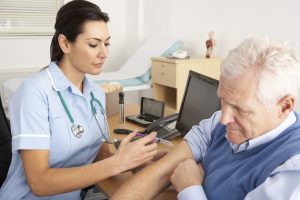
Postherpetic neuralgia and herpes zoster can be reduced by shingles vaccine. A previous study has found that the shingles vaccine may help reduce pain and complications of not only shingles but of postherpetic neuralgia as well. Unfortunately not many adults receive the shingles vaccine thus leading to complications.
The researchers found only 3.9 percent of participants were vaccinated and vaccine rates were lower among blacks and those of lower income.
Over the course of the study nearly 13,000 participants developed shingles and the vaccine reduced the rate by 48 percent. Unfortunately the vaccine was less effective in seniors with weaker immune systems.
The authors said, “Herpes zoster vaccination was associated with a significant reduction in incident herpes zoster and [post-herpetic neuralgia] in routine clinical use. Despite strong evidence supporting its effectiveness, clinical use remains disappointingly low with particularly low vaccination rates in particular patient groups.”
“The findings are relevant beyond US medical practice, being of major importance to the many countries, including the UK, that are actively considering introducing the zoster vaccine into routine practice in the near future,” concluded the authors.
Postherpetic neuralgia causes
Postherpetic neuralgia is a complication of shingles which leads to nerve damage and causes the nerve to malfunction. The faulty nerve sense signals to the brain to signal pain and so the patient may experience pain, throbbing or burning sensations.
Postherpetic neuralgia occurs because in shingles scar tissues forms around the nerves which presses down on them. This leads for inaccurate signals to be sent.
Postherpetic neuralgia symptoms
Symptoms of postherpetic neuralgia include:
- Burning, shooting, or jabbing pain which occurs suddenly
- Constant burning or throbbing pain
- Sensitivity to temperature change
- Itching
- Numbing
- Headaches
- Muscles weakness or paralysis if the affected nerve controls muscles
Postherpetic neuralgia treatment
There are numerous treatments available for postherpetic neuralgia which includes:
- Antidepressants
- Anticonvulsants
- Steroids
- Painkillers
- Transcutaneous electrical nerve stimulation (TENS) – electrodes are placed where the pain occurs and electrical impulses are emitted which work to relieve pain
- Spinal cord or peripheral nerve stimulation – similar to TENS but the devices are implanted beneath the skin along the peripheral nerves
- Lidocaine skin patches – patches which contain lidocaine which is a common anesthetic and antiarrhythmic
Postherpetic neuralgia prevention
Treating shingle immediately can help better prevent postherpetic neuralgia and so at the first sign of shingles visit your doctor right away, especially if you are older and have a weakened immune system.
Other prevention tips for postherpetic neuralgia include:
- Get the chickenpox vaccine
Get the shingles vaccine – check with your doctor if receiving the shingles vaccine is safe as complications may arise if you have a weaker immune system, have undergone chemotherapy, if you are receiving steroids, radiotherapy, if you have active tuberculosis or have untreated tuberculosis or if you have a history of bone marrow of lymphatic cancer.
Sources:
http://www.medicalnewstoday.com/articles/160253.php
http://www.sciencedaily.com/releases/2013/04/130409173504.htm